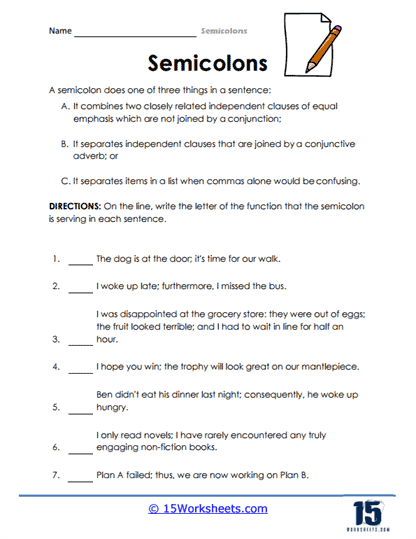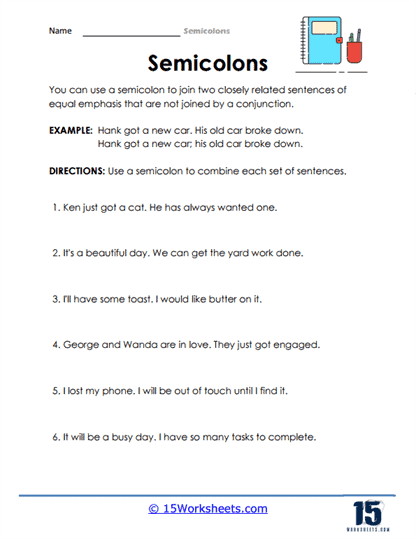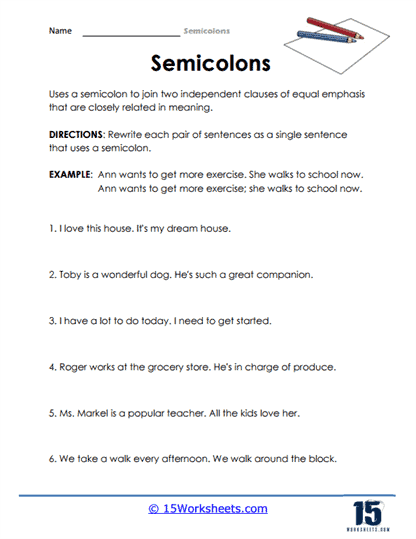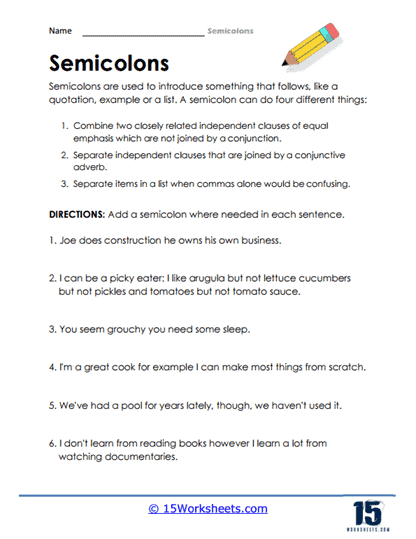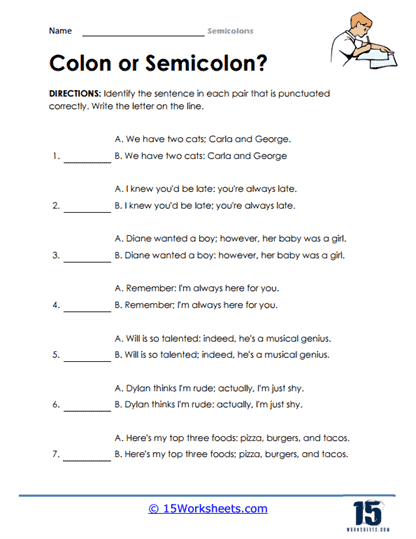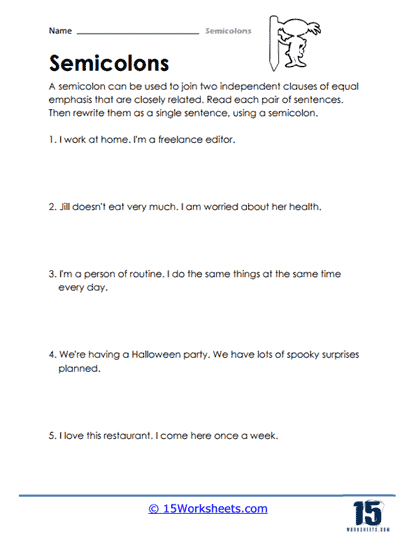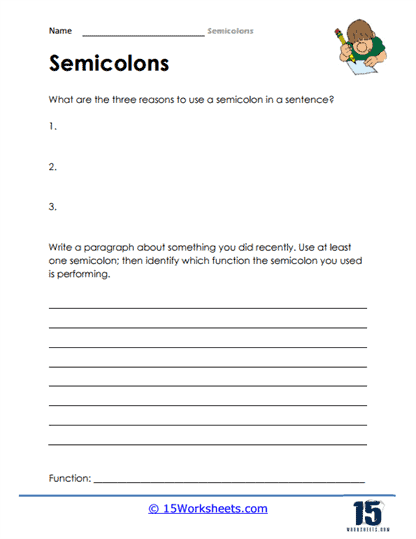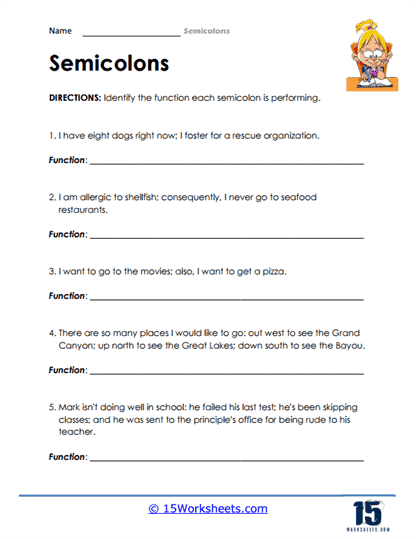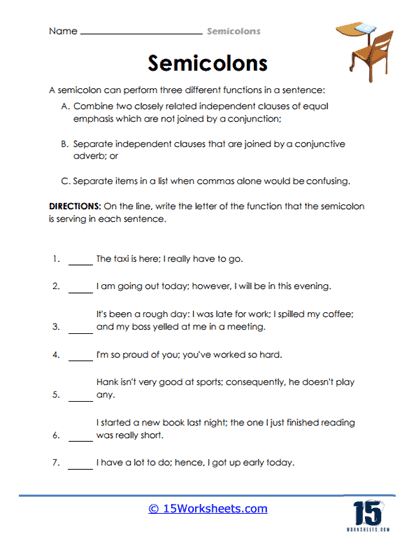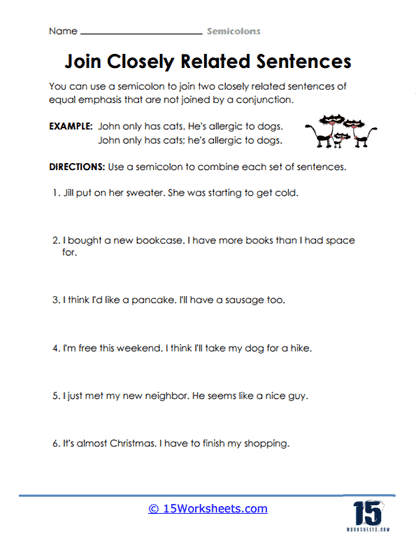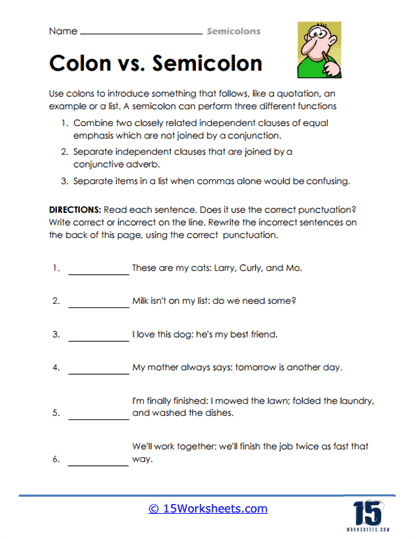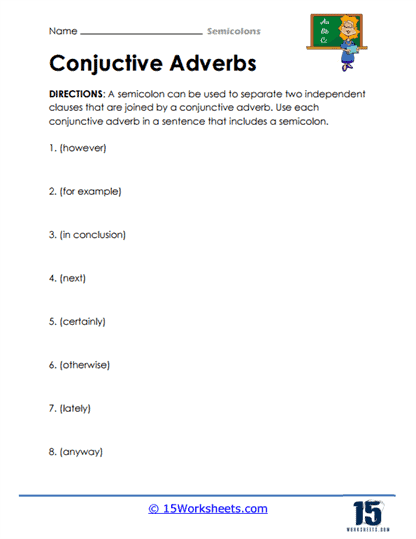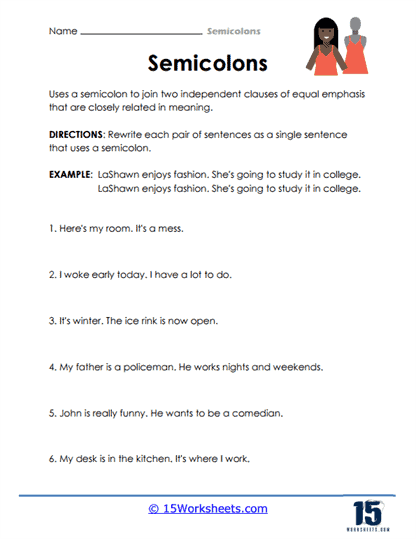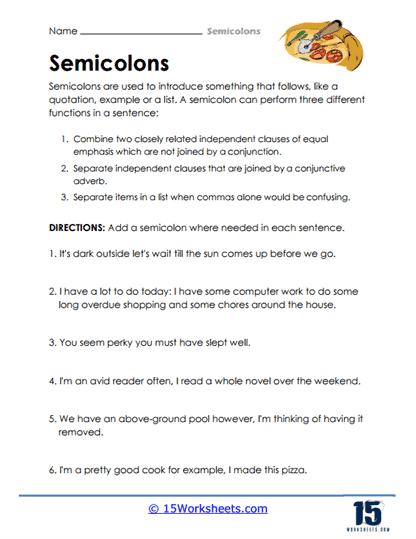Semicolons Worksheets
About These 15 Worksheets
These worksheets are used to teach and reinforce the correct use of semicolons, a critical aspect of English punctuation. These worksheets provide a variety of exercises aimed at helping students understand when and how to use this often-overlooked punctuation mark correctly. By working through these worksheets, students gain a deeper appreciation for the nuances of English grammar and enhance their writing skills.
By consistently practicing with these worksheets, students can develop a stronger command of language, which is a foundational skill that supports academic success and effective communication throughout life. The benefits of these worksheets are multifaceted and enduring, making them a vital component of language education. There are many different types of worksheets available here including:
Correcting Sentences
One common type is the correction exercise, where students are given sentences with incorrect punctuation and must identify and correct the mistakes. This type of exercise is beneficial because it forces students to apply their understanding of semicolon rules actively.
Another popular exercise is the sentence completion task, where students are given two independent clauses and must determine whether a semicolon is necessary to join them correctly. Sometimes these sentences may require a semicolon, while at other times, a period or a comma with a coordinating conjunction might be more appropriate. These tasks teach discernment and the subtleties of clause relationships.
Sentence combining exercises also frequently appear on these worksheets. Here, students are provided with two separate sentences that they must join into a single, fluid sentence using a semicolon. This encourages them to think critically about how ideas are connected and to experiment with different sentence structures.
Conjunctive Adverb Practice
These exercises specifically focus on sentences that use terms like “however,” “therefore,” or “moreover.” Students must place semicolons and commas appropriately around these adverbs to join independent clauses. It helps students learn how to use semicolons in complex sentences to provide clear and effective transitions between thoughts.
List clarification exercises challenge students to use semicolons within complex lists where items themselves contain commas. This teaches students how to avoid confusion and ensure that their writing is easily understandable, particularly when they’re listing long, complicated items or phrases.
The Benefit Of These Worksheets
Practicing with semicolon worksheets can deepen a student’s grammatical knowledge. Semicolons are not as frequently used as commas or periods, and their rules can be more nuanced. By learning these rules, students expand their grammatical toolkit, allowing them to express themselves with greater sophistication and precision.
These worksheets can improve sentence variety in a student’s writing. Often, young writers fall into the habit of using short, choppy sentences, or alternatively, they create run-on sentences by overusing conjunctions. Understanding how to use semicolons allows them to vary their sentence structure, making their writing more engaging and dynamic.
Working with semicolons can sharpen a student’s clarity of expression. Semicolons can clarify complex lists and connect closely related ideas, which is essential for writing clear and cohesive arguments. This skill is invaluable not just in academic writing but in any context where clear communication is key.
Semicolon worksheets can teach the importance of pacing in writing. Semicolons create a pause that is longer than a comma but shorter than a period, allowing a writer to control the rhythm and flow of their sentences more delicately. Understanding this can help students write prose that is more effective and enjoyable to read.
The exercises also foster critical thinking. Deciding whether a semicolon is appropriate requires a student to think critically about the relationship between clauses and the overall structure of a sentence. This kind of decision-making enhances their analytical skills, which are applicable far beyond grammar.
How to Use Semicolons Properly
Semicolons are versatile punctuation marks that can improve the clarity and complexity of sentences when used correctly. There are a few specific rules that guide their use:
Linking Independent Clauses
A semicolon can be used to connect two independent clauses that are closely related in content but could stand on their own as separate sentences. This is often done when the clauses are thematically linked, or when the second clause adds, contrasts, or explains the first.
Example – She can’t attend the meeting tonight; she has prior commitments.
Conjunctive Adverbs and Transitional Phrases
When independent clauses are joined by conjunctive adverbs or transitional phrases like “however,” “therefore,” “moreover,” “nevertheless,” etc., a semicolon is used before the adverb or phrase, and a comma usually follows it.
Example – I planned to study all evening; however, my friends persuaded me to go out.
Complex Lists
When items in a series or list already contain commas, semicolons can be used to separate these items for clarity.
Example – The conference has attendees from Paris, France; Berlin, Germany; and Tokyo, Japan.
Before Bullets or Lists
A semicolon may sometimes be used before bullet points or a list when it follows a complete sentence that introduces the list.
Elliptical Construction
When constructing sentences that have parallel structure or elliptical construction (where words are omitted that are implicitly understood), semicolons can clarify the relationship between the parts.
Example – The first quarter was a loss; the second, a gain.
Common Mistakes When Using Semicolons
Do not use a semicolon with a conjunction
When you connect two clauses with a conjunction like “and,” “but,” or “or,” a semicolon is unnecessary. A comma is typically used in this case.
Incorrect – I wanted to go to the beach; but it started to rain.
Correct – I wanted to go to the beach, but it started to rain.
Do not overuse semicolons
Semicolons should be used sparingly to avoid a stilted or overly formal tone. Too many semicolons can make a paragraph difficult to read and understand.
Do not use a semicolon when a colon is needed
A semicolon is not used to introduce lists or examples; that’s the role of a colon.
Incorrect – I need you to bring me; a pencil, paper, and an eraser.
Correct – I need you to bring me – a pencil, paper, and an eraser.
Do not use a semicolon with dependent clauses
If one of the clauses cannot stand alone as a complete sentence, do not use a semicolon to connect it to an independent clause.
Incorrect – He is going home early today; because he feels ill.
Correct – He is going home early today because he feels ill.
Why Authors Use Semicolons
Semicolons serve as a sophisticated piece of punctuation in an author’s toolkit, often misunderstood and underused, yet highly effective when employed with precision. The semicolon is more nuanced than a comma and less final than a period. It has the unique ability to link closely related ideas within a sentence while still signaling a pause or break that is stronger than a comma but not as definitive as a period.
Authors use semicolons for a variety of reasons. One primary use is to join two independent clauses that are closely related but could stand alone as separate sentences. This usage is particularly useful when the two clauses have a thematic link or when the second clause expands upon, explains, contrasts with, or complements the first.
For example, consider the sentence – “He didn’t want to leave; she hadn’t said goodbye.” The semicolon here connects two distinct actions that are emotionally intertwined. The use of the semicolon imparts a connection that is deeper and more immediate than what a period would convey. Instead of two separate thoughts, the semicolon fuses them into a single complex moment, enhancing the dramatic tension and highlighting the interdependence of the actions.
Another use of semicolons is in complex lists where individual items contain commas. This prevents confusion that could arise from a series of commas. An author may list cities and their corresponding countries, using semicolons to separate each pair. For example – “On his tour, he visited Paris, France; Berlin, Germany; and Tokyo, Japan.” The semicolon makes the sentence clearer and more readable than a simple comma would.
Semicolons can also elegantly connect clauses using conjunctive adverbs or transitional phrases. When authors want to draw attention to the second clause or indicate a shift in tone or direction, they often use a semicolon before words like “however,” “therefore,” or “thus.” For instance – “She was advised to rest; however, she felt there was too much work left undone.” The semicolon sets up the expectation for a pivot or contrast, giving the second clause more emphasis and allowing the reader to anticipate a shift in the narrative flow.
The reason authors reach for semicolons extends beyond grammatical correctness; it’s about rhythm and pace in their writing. Reading a sentence with a semicolon prompts a mental pause, signaling the reader to take note of the connection between the two clauses. The effect of this can be profound, especially in narrative prose where the author wishes to control the reader’s experience of time and the unveiling of information.
When used judiciously, semicolons can also convey a sense of sophistication in writing. They can give text a more formal or academic tone, which can be particularly useful in essays, technical writing, or literature. Their correct usage displays a command of language that can enhance the credibility of the text and the authority of the author.

